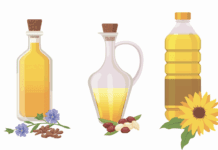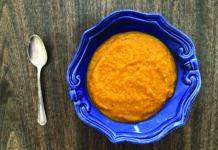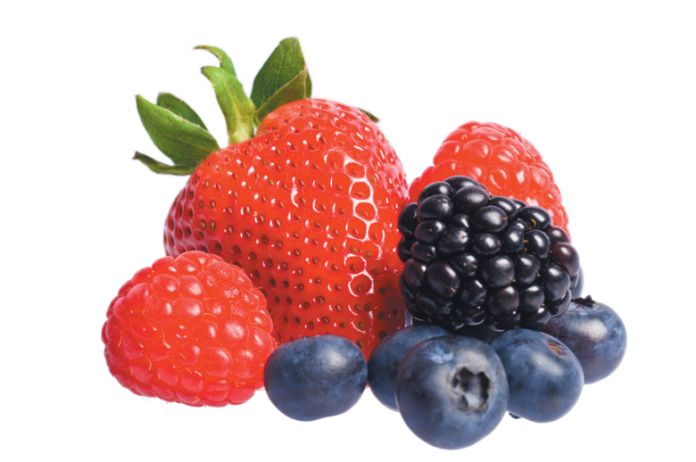Summertime is peak berry season! There’s much to love about these juicy gems. Berries are a good source of fiber, nutrients, and phytochemicals (plant compounds that are active in our bodies). Let’s explore why and how to include nutritious, delicious, and widely available berries in a healthy dietary pattern—now, and all year long.
Here are some tips for getting the most flavor and nutrition from berries, now, and all year long:
EAT A VARIETY: Include a range of berries and other fruits and vegetables to get a variety of nutrients.
GO DEEP: Rich color indicates higher levels of health promoting compounds, so choose ripe, deep-hued berries.
KEEP THEM COOL: Berries are delicate, so refrigerate or freeze them to extend their useable life.
WASH WELL: Rinse or swish delicate berries to remove soil, microbes, and pesticides. Firmer berries can be rubbed gently.
GO BEYOND FRESH: Fresh, frozen, and dried berries are all nutritious and delicious.
EXPLORE: In addition to blueberries and strawberries, give new and different varieties a try.
ENJOY THE SEASON: Although berries are generally available and can be enjoyed year-round, you will still find the best taste (and often lower price) when in season in your area.
Berries and Your Health: Berries are often called “superfoods” and have been credited with a long list of health benefits. While simply eating berries may not ensure good health, they are an excellent source of many phytochemicals. “Phytochemicals from foods may help promote health and potentially protect against some chronic conditions,” says Jeffrey Blumberg, PhD, professor emeritus at Tufts’ Friedman School of Nutrition Science and Policy. According to a recent review of studies, the antioxidant activity of some of the phytochemicals found in berries may contribute to the prevention and treatment of cardiovascular disease, cancer, and diabetes. “If you’re eating food to be healthy, your diet should be rich in phytochemicals, and berries are a good way to get them,” Blumberg says.
If you’re not a fan of berries, fruits and vegetables with similar colors have similar phytochemicals. “Definitely eat blueberries if you like them,” Blumberg says, “but you can also eat purple potatoes and red cabbage. And don’t forget to eat plant foods that provide the other colors of the rainbow, like spinach and kale.”
While the phytochemicals in berries are also found in other plant foods, Dariush Mazaffarian, MD, DrPH, dean of the Friedman School and editor-in-chief of Tufts Health & Nutrition Letter, points out that berries are richer in certain phytochemicals than many other fruits or vegetables. “In observational studies, berries consistently pop up as a key subtype of fruit associated with lower risk of major diseases.” says Mozaffarian. “One of the relatively unique things about berries is that we eat both the fruit and the seeds—a potential reason for greater health benefits.”
If you’re concerned about the high sugar content in most berries, don’t be, Mozaffarian says. “The sugar in berries is contained within the intact structure of the food, greatly slowing the speed of digestion (and therefore reducing bumps in blood sugar) compared to processed foods,” he explains. “Other compounds in berries, in particular the fiber, also slow digestion and offset potential harmful effects of the small amounts of natural sugar. Numerous long-term studies show that people who eat more fruit, including more berries, have lower risk of developing diabetes, strongly arguing against any harms of the sugar.”
Berry Bounty: Fresh berries are wonderful, but the form of the berry matters little in terms of health benefits. In-season, local, fresh berries may be considered the ultimate choice, but there really is no berry season anymore, as fresh berries are available year-round. In any season, frozen berries are a convenient choice, and dried berries are another option with a long shelf life. Alice H. Lichtenstein, DSc, Gershoff Professor of Nutrition Science and Policy at the Friedman School and executive editor of Tufts Health & Nutrition Letter offers a cautionary note: “With dried fruit, unlike fresh fruit, you may end up eating more than intended unless you are mindful of portion sizes,” she says. “It’s best to choose dried fruit that does not have sweeteners. Check the ingredient list for added sugars such as concentrated apple juice.” Dried cranberries are a bit of an exception to this rule. Cranberries are rich in phytochemicals, fiber, and other nutrients, but they are naturally much less sweet than other berries, so they need at least some added sugar for most people to enjoy them. Look for canned or dried cranberries that are only lightly sweetened.
Fruits are most flavorful and nutritious at their peak of ripeness, and berries don’t ripen much after picking. Look for fresh berries that are richly colored, firm, plump, and dry, without mold, bruises, dents, or blemishes.
Wash berries just before use to remove soil, microbes (like E. coli), and pesticides by rinsing them under plain running water. Firmer berries, like strawberries, can be rubbed gently, if necessary. Air dry, spin dry in a salad spinner, or pat dry with a clean cloth or paper towel.
Proper storage is key, as berries are delicate. It’s best to refrigerate them, unwashed, in a container that allows a little airflow. Berries can be frozen, locking in their nutrients and taste for later use: wash, dry, and freeze on a sheet pan before transferring to a plastic bag or container and sealing. (If you don’t mind your berries in clumps, you can skip the sheet pan.) When thawed, frozen berries will be mushy, but they are perfect for smoothies, toppings, and purées , or as mix-ins to plain yogurt or oatmeal.
Just remember that berries are not a cure-all, and they need to be part of an overall healthy dietary pattern. “Berries are a great choice and very versatile in terms of how they can be enjoyed,” says Lichtenstein, “but, although berries can be a delicious addition to many dishes, I’m sorry to say that topping a hot fudge sundae with berries does not make it a healthy choice!”
Try fresh, frozen, and dried berries in a variety of ways:
- Parfait: Layer plain yogurt with berries, granola, nuts, and seeds.
- Cereals: Top hot and cold whole grain cereals or overnight oats with berries.
- Pancakes and waffles: Mix berries into whole grain batter and/or serve them on top instead of syrup.
- Salads: Add berries to salads for a punch of flavor and color.
- Fruit spread: Blend or mash into a spread for whole grain toast and sandwiches.
- Granola: Dried berries bring natural sweetness and unique texture to granola, granola bars, and trail mixes.
- Frozen yogurt: Blend frozen berries with plain yogurt for instant frozen yogurt.
- Infused water: Put crushed fresh berries in your water pitcher overnight to lend flavor.
- Plain: Berries in any form are great on their own.





















Does freezing berries damage or destroy the insoluble fiber? I understand after watching Dr. Robert Lustig’s lectures that freezing fruit destroys the fiber.